Qype ist gerade erst 10 Wochen online und schon heute kaum mehr mit der Startversion zu vergleichen. Vor allem in den letzten zehn Tagen hat das Qype-Team diverse neue Features gelauncht.
In der Summe zeigen sie, wo es hingeht mit Qype: eine lokale Suche, klar. Aber nicht nur für Adressen und Dienstleister, sondern für die Menschen aus meinem Eck. Nie war es einfacher, Gleichgesinnte zu finden, die nur zwei Straßen weiter wohnen.
Wer ist wie ich?
Seit heute prangt auf jeder persönlichen Seite ein fescher Schieberiegel „Qyper, die taggen wie ich“. Wer den Regler nach links auf „Mainstream“ setzt, erhält alle Mitglieder angezeigt, die bestimmte Schlagworte (Tags) genauso oft und gerne benutzen wie man selbst. Bei mir wäre das beispielsweise „Ottensen„. Richtung „Tellerrand“ verschoben, sucht Qype nach den seltener genutzen Tags. (Die Begriffe sind noch nicht final.) Welche Tags der Suche zugrunde liegen, sieht man in der Tagwolke daran, daß sie rot gefärbt und gelb unterlegt sind.
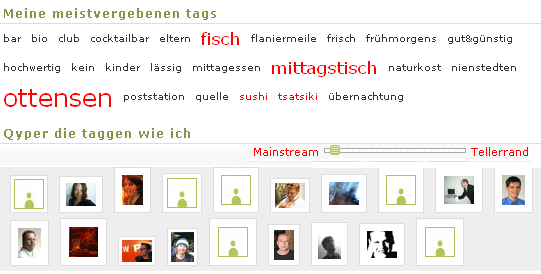
Lieblingsplatz markieren
Mein persönlicher Favorit. Endlich bin ich auch im Internet überall dort präsent, wo ich mich sowieso ständig aufhalte. Lieblingsplatz eben. Mit dieser Funktion läßt sich wunderbar ein „virtueller Tresen“ aufbauen. Also: wer ist auch öfter mal im Reh? Bitte Flagge zeigen (nein, ausnahmsweise mal nicht die deutsche). Die Lieblingsplätze schreien natürlich danach, recht bald mit einer Dating-Funktion angereichert zu werden.
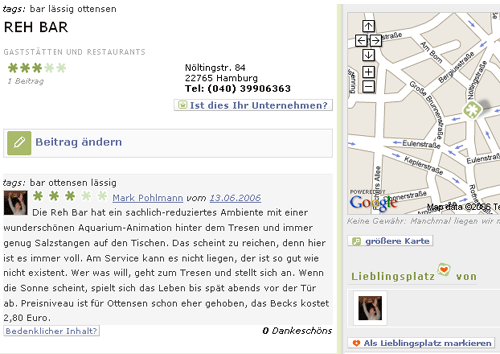
Besucher sehen
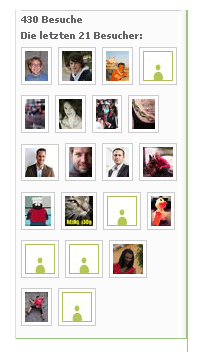
Für wen schreibt man eigentlich den ganzen Kram? Wie jeder weiß (auf jeden Fall jeder, der einen Premium-Account bei OpenBC hat), ist niemand interessanter als derjenige, der sich für mich interessiert. Endlich weiß man auch das: Ich bin es für bislang rund 400 Leutchen gewesen, die ich zudem noch angezeigt bekomme und deren Site ich besuchen kann.
Web 2.0
Es gibt 251 Beiträge in Web 2.0.
WM geht in Führung
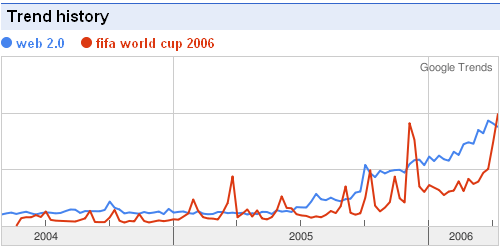
Man muss nur den richtigen Suchbegriff nehmen, und schon liegt die WM vor Web 2.0. Wie sich das gehört. (Und nicht etwa umgekehrt wie neulich.)
Wichtiges in Kürze
Nicht zu verpassen: Markus Breuer verfasst nach einem Jahr Pause wieder seine Notizen aus der Provinz des nördlichen Süd-Ostwestfalen. Zum Beispiel mit der Frage, was der Sinn von Web 2.0 ist.
Philipp Schindler, Nordeuropa-Chef der Internet-Suchmaschine Google, legt via FAZ den deutschen Medienunternehmen „eine Art Kriegserklärung auf den Eichenschreibtisch“ (Peter Turi).
Und Mark Pohlmann mag Unternehmen, die sich selbst kritisieren.
Trendfolger
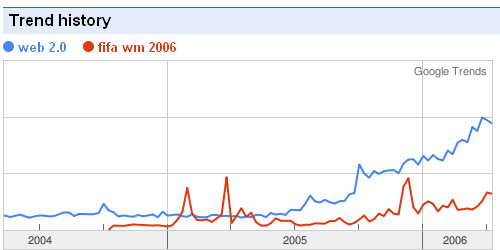
Jetzt geht’s los! Nein, nicht was jetzt jeder denkt. Sondern mit den Web-2.0-Kongressen in Deutschland. Im Oktober findet schon wieder einer statt. Mehr dazu bei next10years.com.
Kein Web-2.0-Event
Auch Kongressveranstalter, zumal mit der Erfahrung und dem Standing eines Thomas Madsen-Mygdal, haben ein Distinktionsbedürfnis. Die reboot, in diesem Jahr schon in der achten Auflage, ist kein Web-2.0-Event. Na sowas? Themenblogger Mark Pohlmann war dabei. Hier sein Bericht.
Die Ebay-Blogs sind da
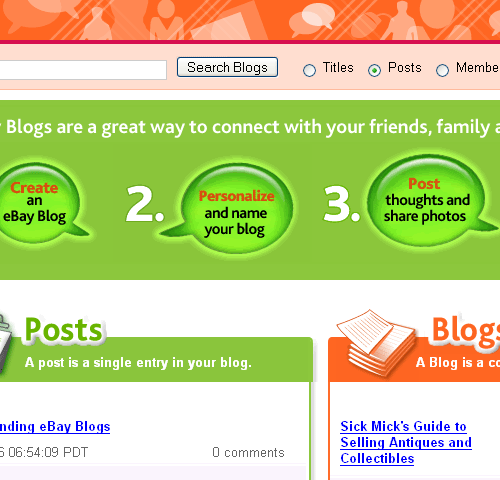
Das meldet der Haltungsturner. Sehr schön erklärt: der Weg zum eigenen Blog und die Basisbegriffe („Posts“ und „Blogs“).
Die Vorgeschichte bei Exciting Commerce. Und Robert „Thinking“ Basic hat Probleme mit der Policy.
Readers Edition
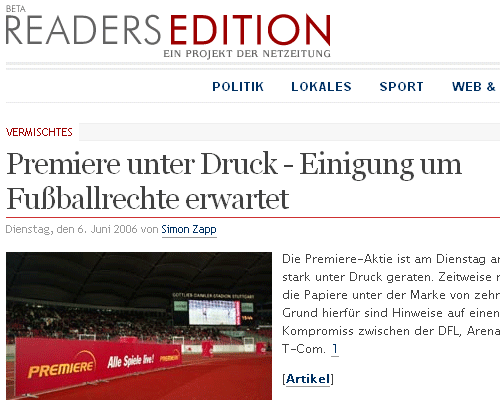
Die lang erwartete Readers Edition der Netzeitung ist da. Erste Stimmen aus dem Netz:
Die Idee ist gut, warten wir ab, ob die Welt dafür schon bereit ist. (Johnny Haeusler, Spreeblick)
Es ist ein sehr, sehr spannendes Projekt, das extrem viele wache Augen benötigt. Funktioniert es, setzt es vielleicht sogar international einen Maßstab. (Thomas Knüwer, Indiskretion Ehrensache)
Zumindest die ersten bereits eingereichten Artikel lassen gutes hoffen… (BloggingTom)
Das Layout wirkt sachlich, aber nicht unschick. Und auch nicht so unaufgeräumt-durcheinander wie bei vielen Newsseiten. (Robert Basic, Basic Thinking]
Der Gipfel
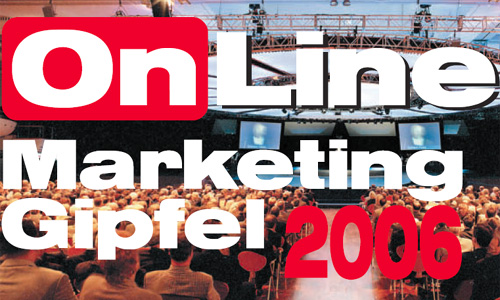
Kongresse, Kongresse, Kongresse. Wer noch nicht genug hat, kann Ende dieser Woche den Online Marketing Gipfel 2006 in Wiesbaden besuchen. Das Verhältnis von Anzug- zu Jeansträgern dort wird reziprok zur reboot sein. Ein paar Gründe für die Reise:
- Bernd M. Michael, zuletzt durch seine Ansprache zum New Media Award positiv aufgefallen, spricht gleich nach dem Grußwort über „Online Kommunikation – Stammspieler oder nur Reservebank?“.
- Christian Magel stellt simyo vor („Generationenwechsel im Mobilfunk: simyo – Die Erfolgsstory mit Pure play Internet“).
- Markus Krechting referiert über „Neckermann auf dem Weg zur E-Commerce-driven Company – Die Zukunft liegt im Internet“.
- Tim von Törne präsentiert Skype zum Thema „Internettelefonie und eMarketing – wie bringt man diese Bereiche zusammen?“.
- PR-Blogger Klaus Eck darf das Thema Web 2.0 („Chancen und Risiken“) vertreten.
- Und schließlich Martin Oetting: „Online Marketing Trends: Marketing im 21. Jahrhundert – Dank kollektiver Intelligenz“
Blogshopper
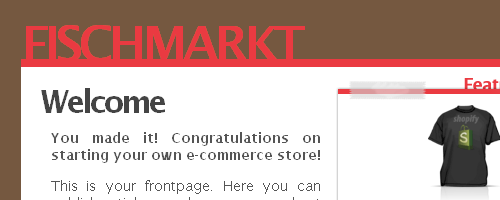
Shopify wechselt von der Beta– in die Sneak-Preview-Phase. So sieht mein neuer, völlig unbehandelter Shopify-Shop aus. Das Admin-Interface verspricht einiges: Unter „Blogs & Pages“ lassen sich nicht nur statische HTML-Seiten, sondern auch ganze Blogs anlegen. Mal schauen, welche Features die Plattform bietet. Vielleicht ist ja Shopify in Bälde die Lösung der Wahl für jeden bloggenden Verkäufer oder verkaufenden Blogger?
Nachtrag: Klaas Wilhelm Bollhöfer analysiert, warum eher nicht.
Wird fortgesetzt.
Web 2.0 ist keine Schnecke
Weil es so schön ist, was Jürgen Ahting da ausgegraben hat, hier in voller Länge:
On the subject of broadcast vs broadband, Tom writes:
There’s nothing rapid about this transition at all. It’s been happening in the background for fifteen years. So let me rephrase it in ways that I understand. Shock revelation! A new set of technologies has started to displace older technologies and will continue to do so at a fairly slow rate over the next ten to thirty years!
…
My sense of these media organisations that use this argument of incredibly rapid technology change is that they’re screaming that they’re being pursued by a snail and yet they cannot get away! ‚The snail! The snail!‘, they cry. ‚How can we possibly escape!?‘. The problem being that the snail’s been moving closer for the last twenty years one way or another and they just weren’t paying attention.In comments, Will writes:
If one person is claiming that the world is moving fairly slowly, and has some sound advice on what this might look like (as you are doing here), and another person is claiming that the world is moving extraordinarily quickly, but offers some quickfire measures through which to cope with this, the sense of emergency will win purely because it is present. From here, it almost becomes *risky* not to then adopt the quickfire measures suggested by the second person. Panic becomes a safer strategy than calmness. Which explains management consultancy…
and John asks:
does web2.0 count as a snail too?
But Web 2.0 is not a snail.
Web 2.0 is the people pointing and shouting ‚The snail! The snail!‘
Web 2.0 is also the people who overhear the first group and join in, shouting ‚The whale! The whale!‘ and pointing vaguely upwards and towards the nearest ocean.
Web 2.0 is also the people who hear the second group and panic about the approaching whale, or is it a land-whale? what is a land-whale anyway? whatever it is, there’s one coming and we’d all better… well, we’d better tell someone about it, anyway – I mean, there’s a land-whale coming, how often does something like that happen?
Web 2.0 is also the people who hear the third group and improvise a land-whale parade, with floats and dancers and drummers and at its centre a giant paper land-whale held aloft by fifteen people, because, I don’t know, but everyone was talking about land-whales and it just seemed like a good idea, you know?
And Web 2.0 is the people who come along halfway through the parade and sell the roadside spectators standing-room tickets.
Man beachte auch den Kommentar von Dharmesh Shah:
Absolutely brilliant.
I’d thought I’d read all the possible variations of definitions on Web 2.0 that there could be.
This is by far, one of the most insightful. I have a master’s thesis I’m working on that covers „Web 2.0 Business Models — An Oxymoron“. This might be a good fit.
